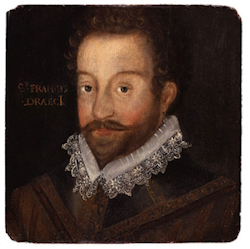 The explorer and privateer Sir Francis Drake was one of the most famous English historical personalities, best known for circumnavigating of the world and playing an important role in defeating the Spanish Armada. To the Spanish he was an infamous pirate known as El Draque (The Dragon in old Spanish), but to the English he was a national hero. He was born in about 1540 in Tavistock near Plymouth, Devon, but grew up in Kent. He was the oldest of twelve boys and his father, Edmund Drake, was a preacher. At the age of twelve Drake became an apprentice to the master of a small freight vessel, which he later inherited. Not satisfied with the life of a coastal trader, he sold the vessel and returned to Plymouth, where he had contacts – John and William Hawkins, who were possibly his cousins. He sought employment on their voyages. Drake married Mary Newman in 1569, but not much is known about her. She died in 1583 and he subsequently married Elizabeth Sydenham in 1585. Drake was extremely active in the Anglo-Spanish War (1585-1604).
The explorer and privateer Sir Francis Drake was one of the most famous English historical personalities, best known for circumnavigating of the world and playing an important role in defeating the Spanish Armada. To the Spanish he was an infamous pirate known as El Draque (The Dragon in old Spanish), but to the English he was a national hero. He was born in about 1540 in Tavistock near Plymouth, Devon, but grew up in Kent. He was the oldest of twelve boys and his father, Edmund Drake, was a preacher. At the age of twelve Drake became an apprentice to the master of a small freight vessel, which he later inherited. Not satisfied with the life of a coastal trader, he sold the vessel and returned to Plymouth, where he had contacts – John and William Hawkins, who were possibly his cousins. He sought employment on their voyages. Drake married Mary Newman in 1569, but not much is known about her. She died in 1583 and he subsequently married Elizabeth Sydenham in 1585. Drake was extremely active in the Anglo-Spanish War (1585-1604).
Drake’s early career
Francis Drake was employed by the Hawkins brothers, his first job being a purser on a ship. John Hawkins was involved in the slave trade and illegal trading in the West Indies. Drake accompanied him as an officer – he is said to have been a common sailor on the first two voyages – on his third voyage in 1566, which also involved plundering Portuguese merchant vessels and attempting to sell the stolen goods to the Spanish in the colonies, but the Spanish refused to trade with Hawkins’ expedition. Drake also joined the fourth expedition of six ships, including two warships, in 1567. After failing to find gold in Africa they captured slaves to sell instead, although this didn’t go so well. They finally managed to obtain about 400 slaves before sailing to the Caribbean with Drake in charge of a small vessel called the Judith. At the town of Rio de la Hacha they received a cold welcome, so they first blockaded before storming it in attempt to force the Spanish to trade with them. In September 1568, the ships were forced by a storm into the port of San Juan de Ulúa near Vera Cruz and needed to make repairs – Spain and England were not at war at the time. The Viceroy of New Spain, Martín Enríquez de Almanza, then arrived with a fleet of ships to find Hawkins occupying the harbour. While still negotiating for supplies and the opportunity to carry out repairs, Hawkins’ ships were attacked by the Spanish in what became known as the Battle of San Juan de Ulúa, which ended in a defeat for the English, who fled back to England with the loss of several hundred men, arriving home four months later. Hawkins only just made it back alive and accused Drake of desertion and theft, which Drake vehemently denied. After this point Drake developed a hatred of the Spanish.
Drake’s first command
Drake went on several minor voyages to the West Indies between 1570 and 1571. In 1572, he undertook a voyage to the Spanish Main with the intent to intercept gold and silver from the colonies. He left Plymouth on 24th May 1572, with a crew of 73 men in two small vessels: Pascha (70 tons) and Swan (25 tons). His first raid was on Nombre de Dios in Panama in July of that year. He was wounded and although initially successful was forced to retreat when Spanish reinforcements arrived. Next he seized galleons along the coast and mule trains on land. He blockaded Cartagena, but was too weak to take it. He joined forces with the French privateer Guillaume Le Testu, who was in command of the 80-ton warship Havre, and a group of maroons (escaped slaves) with whom he eventually managed to capture a mule train carrying silver near Nombre de Dios after some initial setbacks, seizing more than 200,000 pesos worth of silver. Too much to carry, Drake buried some of the treasure before they returned to the coast. Le Testu was later captured and executed. Arriving at the coast they discovered their boats were gone, so after burying the rest of their loot they eventually found some boats and eventually made it back to Plymouth in August 1573. Due to a peace treaty signed between Spain and England, it wasn’t possible to publicly acknowledge Drake’s exploits, but he was considered a hero in England and a pirate by the Spanish, whom he had humiliated.
Circumnavigation of the Globe
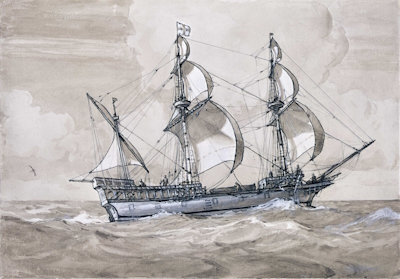 After taking part in the conflict in Ireland, supporting the Earl of Essex and being involved in the Rathlin Massacre, which took place on 26th July 1575, when 600 Scots and Irish were killed, he set off on another voyage to the Caribbean. This time he was part of a private syndicate financed by wealthy backers, including John Hawkins, and possibly Queen Elizabeth, although she never issued him an official commission. The expedition consisting of five ships finally left Plymouth on 13th December 1577 after initial setbacks caused by bad weather. Drake sailed on the Pelican. After a difficult voyage, plundering Spanish ships and settlements on the coast of Africa as he went, he finally arrived in the bay of Puerto San Julián in Argentina after the loss of two vessels. Later on during the voyage, Drake charged Thomas Doughty, a gentleman and therefore Darke’s social superior, who was accompanying him, with mutiny and had him executed after several quarrels and an attempt by Doughty to undermine Drake’s authority. In September 1578, Drake entered the Pacific via the Magellan Straits with three ships, where he and his men had some violent encounters with the indigenous people there. Shortly after his arrival in the Pacific one of his ships, Marigold, was destroyed in a storm, and another, Elizabeth, commanded by Captain Winter became separated and chose to to turn back, leaving Drake with only the Pelican, which he later renamed the Golden Hind in honour of one of the voyage’s backers, Sir Christopher Hatton, whose family crest was a hind. Drake was injured on the island in a skirmish with the Mapuche, who made no distinction between the Spanish and the English, on Mocha Island off the coast of Chile. He then sailed north along the Pacific coast of South America, attacking Spanish ports and pillaging towns, including attacking the port of Valparaíso and capturing the treasure ship Nuestra Señora de la Concepción, which was sailing to Manila and carrying vast amounts of gold and silver.
After taking part in the conflict in Ireland, supporting the Earl of Essex and being involved in the Rathlin Massacre, which took place on 26th July 1575, when 600 Scots and Irish were killed, he set off on another voyage to the Caribbean. This time he was part of a private syndicate financed by wealthy backers, including John Hawkins, and possibly Queen Elizabeth, although she never issued him an official commission. The expedition consisting of five ships finally left Plymouth on 13th December 1577 after initial setbacks caused by bad weather. Drake sailed on the Pelican. After a difficult voyage, plundering Spanish ships and settlements on the coast of Africa as he went, he finally arrived in the bay of Puerto San Julián in Argentina after the loss of two vessels. Later on during the voyage, Drake charged Thomas Doughty, a gentleman and therefore Darke’s social superior, who was accompanying him, with mutiny and had him executed after several quarrels and an attempt by Doughty to undermine Drake’s authority. In September 1578, Drake entered the Pacific via the Magellan Straits with three ships, where he and his men had some violent encounters with the indigenous people there. Shortly after his arrival in the Pacific one of his ships, Marigold, was destroyed in a storm, and another, Elizabeth, commanded by Captain Winter became separated and chose to to turn back, leaving Drake with only the Pelican, which he later renamed the Golden Hind in honour of one of the voyage’s backers, Sir Christopher Hatton, whose family crest was a hind. Drake was injured on the island in a skirmish with the Mapuche, who made no distinction between the Spanish and the English, on Mocha Island off the coast of Chile. He then sailed north along the Pacific coast of South America, attacking Spanish ports and pillaging towns, including attacking the port of Valparaíso and capturing the treasure ship Nuestra Señora de la Concepción, which was sailing to Manila and carrying vast amounts of gold and silver.
The return voyage
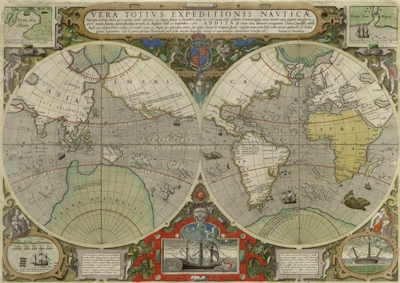 In June 1579, Drake sailed as far north as Coos Bay in Oregon in an attempt to avoid the Spanish before sailing back to England via the Pacific. Sailing back south, they landed in northern California and claimed the area for the English crown, naming it New Albion. After spending several weeks there careening and preparing themselves for the long voyage they finally left on 23rd July. It was deemed too risky to return by the same route, as the Spanish were now alerted to their presence, so they decided to sail across the Pacific, which they did for 68 days before sighting land. Eventually they reached the Moluccas and Spice Islands in Indonesia. At one point the Golden Hind was caught on a reef for three days, almost being lost for good. Later, after allying himself with Sultan Babullah of Ternate of the Moluccas against the Portuguese, Drake sailed onwards, rounding the Cape of Good hope and reaching Sierra Leon in July 1580. They sailed into Plymouth Sound with a vast amount of loot in September of the same year after being away for three years in total. There was no fanfare on his return, because Queen Elizabeth desired to keep the voyage and all its records secret to avoid conflict with Spain, although Drake was rewarded with the valuable Drake Jewel, a pendant surrounded by diamonds, rubies and pearls, and he eventually received a knighthood in April 1581. Despite attempts, his exploits couldn’t be kept hidden and the Spanish were outraged, demanding Drake’s punishment.
In June 1579, Drake sailed as far north as Coos Bay in Oregon in an attempt to avoid the Spanish before sailing back to England via the Pacific. Sailing back south, they landed in northern California and claimed the area for the English crown, naming it New Albion. After spending several weeks there careening and preparing themselves for the long voyage they finally left on 23rd July. It was deemed too risky to return by the same route, as the Spanish were now alerted to their presence, so they decided to sail across the Pacific, which they did for 68 days before sighting land. Eventually they reached the Moluccas and Spice Islands in Indonesia. At one point the Golden Hind was caught on a reef for three days, almost being lost for good. Later, after allying himself with Sultan Babullah of Ternate of the Moluccas against the Portuguese, Drake sailed onwards, rounding the Cape of Good hope and reaching Sierra Leon in July 1580. They sailed into Plymouth Sound with a vast amount of loot in September of the same year after being away for three years in total. There was no fanfare on his return, because Queen Elizabeth desired to keep the voyage and all its records secret to avoid conflict with Spain, although Drake was rewarded with the valuable Drake Jewel, a pendant surrounded by diamonds, rubies and pearls, and he eventually received a knighthood in April 1581. Despite attempts, his exploits couldn’t be kept hidden and the Spanish were outraged, demanding Drake’s punishment.
The outbreak of war with Spain
On his return, Francis Drake became involved in politics. He became the Member of Parliament for Camelford in January 1581 and Mayor of Plymouth in September. When war broke out with Spain in 1585, he led an expedition of 21 ships and 1800 men to attack Spain’s colonies in the West Indies. On the way, Drake threatened to attack Vigo in Spain if the town didn’t give his fleet supplies, and his force also plundered Santiago in the Cape Verde Islands. After arriving in the West Indies, Drake’s expedition sacked the port of Santo Domingo on Hispaniola and captured the city of Cartagena de Indias in Colombia. Although generally successful, disease took a heavy toll on Drake’s fleet and he sailed for home without attacking his real targets: Havana and Panama. He sailed back to England via the colony on Roanoke Island in North Carolina, destroying the Spanish fort of St. Augustine in Florida, a possible threat to the colonists, on the way. He finally reached England on 22nd July 1586. Drake then accepted a privateering commission to continue waging war against the Spanish. He was to disrupt Spanish shipping and prevent the planned invasion armada from reaching English shores. A pre-emptive strike was decided on to stop, or at least slow down, the Spanish fleet. Drake led a raid on Cádiz, the centre of Spain’s maritime power, on 19th April 1587, inflicting heavy damage on the Spanish fleet – Drake himself claiming to have destroyed 39 ships. After that, he returned to England after causing havoc among Spanish shipping, blockading Lisbon, and seizing a ship laden with silver and gold.
The defeat of the Spanish Armada
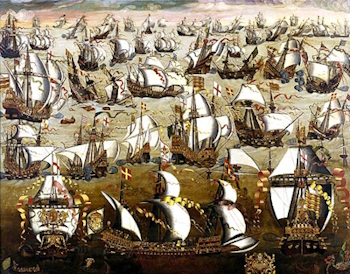 In May 1588, Drake was made vice admiral of the English fleet under Lord Howard of Effingham, which was to act against the Spanish Armada of 73 warships, which were sailing towards England with the intent of securing the way for an invasion force of 20,000 men. Drake’s ship, Revenge, was one of 55 that set out from Plymouth. In a manoeuvre that put himself and the English fleet in jeopardy, he captured the Spanish galleon Nuestra Señora del Rosario, which was carry 50,000 gold coins. Drake subsequently took part in the battle off Gravelines after the Spanish ships had been dispersed by eight fireships the previous night. When the remnants of the Armada fled north Drake was one of those pursuing them to prevent them from landing on English soil. Although the English ships were out of powder and shot, they forced the Spanish to sail around the northern tip of Scotland and west coast of Ireland, where many Spanish ships were lost in storms. In total, some 63 Spanish ships were lost in the fateful expedition. Despite his heedless action against Nuestra Señora del Rosario, Drake was considered a hero. With the defeat of the Armada, he had reached the high-point of his career.
In May 1588, Drake was made vice admiral of the English fleet under Lord Howard of Effingham, which was to act against the Spanish Armada of 73 warships, which were sailing towards England with the intent of securing the way for an invasion force of 20,000 men. Drake’s ship, Revenge, was one of 55 that set out from Plymouth. In a manoeuvre that put himself and the English fleet in jeopardy, he captured the Spanish galleon Nuestra Señora del Rosario, which was carry 50,000 gold coins. Drake subsequently took part in the battle off Gravelines after the Spanish ships had been dispersed by eight fireships the previous night. When the remnants of the Armada fled north Drake was one of those pursuing them to prevent them from landing on English soil. Although the English ships were out of powder and shot, they forced the Spanish to sail around the northern tip of Scotland and west coast of Ireland, where many Spanish ships were lost in storms. In total, some 63 Spanish ships were lost in the fateful expedition. Despite his heedless action against Nuestra Señora del Rosario, Drake was considered a hero. With the defeat of the Armada, he had reached the high-point of his career.
The failure of the English Armada
In 1589, Drake co-led a retaliatory raid against the Spanish together with Sir John Norris. One of its aims was to destroy the remainder of the Spanish fleet, another was to land in Portugal and incite a rebellion against King Philip II of Spain, who was also King of Portugal. The expedition was overambitious, being poorly funded and badly planned. Drake’s force was repelled when attempting to blockade Coruña, setting his plans back a couple of weeks. The attack on Lisbon also failed due to lack of supplies with no revolt materialising. On the voyage back to England, Drake attacked and pillaged the Galician town of Vigo, but was eventually driven off by the arrival of reinforcements, suffering quite a few casualties. The disaster is said to have cost between 8000 and 11,000 lives amongst Drakes soldiers and sailors. After this fiasco, Drake fell out of favour at court.
Drake’s end
In 1595 Drake was his fifties, but not yet wishing to retire, he took part in a less than successful expedition in the Caribbean against the Spanish under joint command together with John Hawkins, but the Spanish were better prepared this time. A failed assault on Las Palmas in the Canary Islands was followed by a disastrous campaign in the Caribbean, especially after the death of Hawkins. Drake was defeated in the Battle of San Juan in Puerto Rico, although he did have some minor successes in taking Rio de la Hacha and Santa Marta, but then decided against attacking Cartagena with his depleted force. Not being one to give up easily, he captured Nombre de Dios, which had already been abandoned by its defenders, and marched on the city of Panama. Francis Drake died of dysentery there after his failed assault on the city in January 1596. He was buried in a lead lined coffin, which was lowered by HMS Defiance, off the coast of Porto Bello in January 1596. The English fleet withdrew after his death.
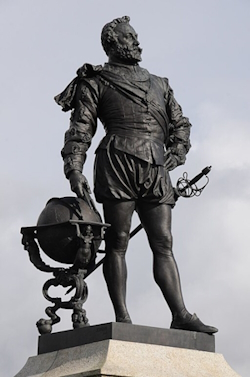 Drake was an ambitious commoner who did well for himself, receiving a knighthood and adopting the motto Sic Parvis Magna, which means: “Great achievements from small beginnings”. He deplored unnecessary violence and can even be considered a humanist: casualties were minimal in boarding actions; he never tortured his prisoners; he invited captured captains to dine with him, even giving them gifts; he treated the natives of the Americas well. Although he declared a personal war on the Spanish, he wasn’t a vengeful man and rarely killed them himself. On one occasion he refused to exact revenge for the murder of two of his men by natives on Mocha island. He is said to have thought the natives had suffered enough under the Spanish. Although he was involved in the slave trade at the beginning of his career, he is generally thought later to have frowned upon it, even freeing all the slaves after capturing Santo Domingo and Cartegena. Drake was a man of many talents: he was an artist, who loved painting the exotic wildlife he saw on his travels, as well as making geographical and navigational records; he was a politician, being the Member of Parliament for three constituencies: Camelford in January 1581, when he was also mayor of Plymouth; Bossiney in 1584, and Plymouth in 1593. He was an explorer who claimed lands for the Crown, such as New Albion on the west coast of North America, but also having some of the places he had discovered named after himself over the year, including: Drakes Bay on the northern coast of California; Drake Passage at the southern tip of South America; Drake’s Island in Plymouth Sound. Despite all his successes, this common sailor who became a national figure never had an heir to pass his legacy on to.
Drake was an ambitious commoner who did well for himself, receiving a knighthood and adopting the motto Sic Parvis Magna, which means: “Great achievements from small beginnings”. He deplored unnecessary violence and can even be considered a humanist: casualties were minimal in boarding actions; he never tortured his prisoners; he invited captured captains to dine with him, even giving them gifts; he treated the natives of the Americas well. Although he declared a personal war on the Spanish, he wasn’t a vengeful man and rarely killed them himself. On one occasion he refused to exact revenge for the murder of two of his men by natives on Mocha island. He is said to have thought the natives had suffered enough under the Spanish. Although he was involved in the slave trade at the beginning of his career, he is generally thought later to have frowned upon it, even freeing all the slaves after capturing Santo Domingo and Cartegena. Drake was a man of many talents: he was an artist, who loved painting the exotic wildlife he saw on his travels, as well as making geographical and navigational records; he was a politician, being the Member of Parliament for three constituencies: Camelford in January 1581, when he was also mayor of Plymouth; Bossiney in 1584, and Plymouth in 1593. He was an explorer who claimed lands for the Crown, such as New Albion on the west coast of North America, but also having some of the places he had discovered named after himself over the year, including: Drakes Bay on the northern coast of California; Drake Passage at the southern tip of South America; Drake’s Island in Plymouth Sound. Despite all his successes, this common sailor who became a national figure never had an heir to pass his legacy on to.
For more information on Francis Drake watch the detailed video Sir Francis Drake: England’s Greatest Hero by the Dan Davis History YouTube channel.
